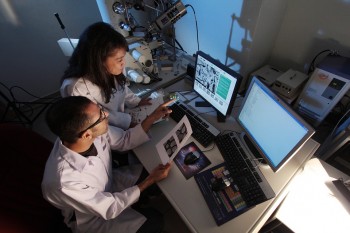BOSTON � A study led by researchers at Beth Israel Deaconess Medical Center (BIDMC) offers a new explanation for how the brain makes adjustments to the body's metabolic rate to prevent extra calories from turning into extra pounds.
The findings, which could ultimately aid researchers in identifying mutations that cause obesity as well as in developing anti-obesity drugs, appear in the Aug. 2 issue of Science.
The key lies in a process known as diet-induced thermogenesis, an intricate system of communications masterminded by the brain which literally means "heat production," according to the study's senior author Bradford B. Lowell, M.D., Ph.D., of BIDMC's department of endocrinology.
"The body requires a certain number of calories in order to function and maintain good health," explains Lowell, who is also an associate professor of medicine at Harvard Medical School. "When the body takes in more calories than it needs, it either converts the extra into stored fat, which sticks around and can lead to obesity, or it converts them into heat, which is subsequently dissipated."
The idea that diet-induced thermogenesis can play an important role in preventing obesity has been widely assumed and is the basis of many weight-loss programs and products, but until now, there was no direct explanation for how this was happening.
Continue Reading Below ↓↓↓
"It's been thought that diet-induced thermogenesis takes place by way of the sympathetic nervous system when a group of molecules known as beta adrenergic receptors (betaARs) act on thermogenically active target tissues to prevent weight gain," says Lowell. These receptors are "turned on" by neurotransmitters released from sympathetic nerve endings.
The target tissue most often cited as the source of this activation is known as brown adipose tissue (BAT), so named for its brown appearance, which is due to the abundant mitochondria that function to expend calories and thereby burn excess fat. Other thermogenic target tissues, such as skeletal muscle, may also prove to be relevant to the process.
Together with lead author Eric Bachman, M.D., Ph.D., Lowell tested the hypothesis that betaARs were behind the process of diet-induced thermogenesis by creating a group of knockout mice lacking all three of the known beta adrenergic receptors (beta-less mice). Over an eight-week period, the researchers then compared the beta-less mice with a group of wild-type control mice when the animals were fed two separate diets: The first, a bland diet of standard rodent chow and the second, a high-calorie diet loaded with fat and sugar.
According to the authors, the chow-based diet yielded minimal differences between the two groups. "The beta-less mice had a modestly reduced metabolic rate and were slightly obese, compared with the control mice," says Lowell. However, he adds, among the animals who were fed the high-calorie, high-fat diet, the differences were dramatic.
"When we interfered with the mouse's sympathetic nervous system by removing the three beta adrenergic receptors, the mice fed a high-fat diet grew massively obese," says Lowell, noting that the beta-less mice gained 26 grams compared with gains of only seven grams among the control mice.
Adds Bachman, "This was not a question of food intake. Both the beta-less mice and the control mice ate the same amounts, but because the beta-less group could not expend the extra calories, they grew very fat."
These findings, says Lowell, indicate not only that beta adrenergic receptors are necessary for the process of diet-induced thermogenesis, but that the process has an important role in preventing obesity.
"In the control mice, it was clear that a process was 'switched on' as soon as they were fed diets high in fat and calories," he notes. "The betaAR pathway has been proposed to exist for many years, but previous research was unsuccessful in proving its importance for diet-induced thermogenesis. In this study, we've done something more selective by creating genetically engineered mice with no capability at all for betaAR action."
The next step, he says, will be to identify the tissue that is being activated by betaARs to produce the diet-induced thermogenesis. "Moving forward, we now have a tool with which to discern the other parts of the system, which may ultimately lead to the identification of mutations that cause obesity in humans, and may help us find anti-obesity drug targets."
In addition to Bachman and Lowell, study co-authors include BIDMC researchers Harveen Dhillon, Ph.D., and Chen-Yu Zhang, M.D., Ph.D.; Saverio Cinti, M.D., of the University of Ancona, Italy; Antonio Bianco, M.D., Ph.D., of Brigham and Women's Hospital, Boston; and Brian Kobilka, M.D., of Howard Hughes Medical Institute, Stanford University Medical School, California. The research was funded by grants from the National Institutes of Health and Eli Lilly and Company. Beth Israel Deaconess Medical Center is a major patient care, research and teaching affiliate of Harvard Medical School and a founding member of CareGroup Healthcare System. Beth Israel Deaconess is the third largest recipient of National Institutes of Health research funding among independent U.S. teaching hospitals.
Continue Reading Below ↓↓↓
Source: Beth Israel Deaconess Medical Center










